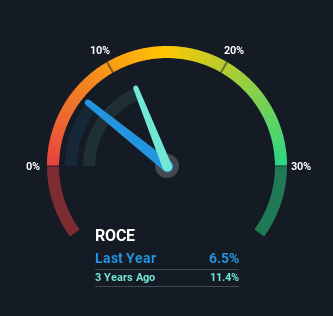These Return Metrics Don't Make Barnes Group (NYSE:B) Look Too Strong
When we're researching a company, it's sometimes hard to find the warning signs, but there are some financial metrics that can help spot trouble early. Typically, we'll see the trend of both return on capital employed (ROCE) declining and this usually coincides with a decreasing amount of capital employed. This indicates the company is producing less profit from its investments and its total assets are decreasing. So after we looked into Barnes Group (NYSE:B), the trends above didn't look too great.
Return On Capital Employed (ROCE): What is it?
For those that aren't sure what ROCE is, it measures the amount of pre-tax profits a company can generate from the capital employed in its business. Analysts use this formula to calculate it for Barnes Group:
Return on Capital Employed = Earnings Before Interest and Tax (EBIT) ÷ (Total Assets - Current Liabilities)
0.065 = US$147m ÷ (US$2.6b - US$308m) (Based on the trailing twelve months to September 2021).
Therefore, Barnes Group has an ROCE of 6.5%. In absolute terms, that's a low return and it also under-performs the Machinery industry average of 10%.
View our latest analysis for Barnes Group
In the above chart we have measured Barnes Group's prior ROCE against its prior performance, but the future is arguably more important. If you'd like, you can check out the forecasts from the analysts covering Barnes Group here for free.
What The Trend Of ROCE Can Tell Us
There is reason to be cautious about Barnes Group, given the returns are trending downwards. To be more specific, the ROCE was 9.4% five years ago, but since then it has dropped noticeably. And on the capital employed front, the business is utilizing roughly the same amount of capital as it was back then. Since returns are falling and the business has the same amount of assets employed, this can suggest it's a mature business that hasn't had much growth in the last five years. So because these trends aren't typically conducive to creating a multi-bagger, we wouldn't hold our breath on Barnes Group becoming one if things continue as they have.
What We Can Learn From Barnes Group's ROCE
In summary, it's unfortunate that Barnes Group is generating lower returns from the same amount of capital. Investors must expect better things on the horizon though because the stock has risen 2.0% in the last five years. Regardless, we don't like the trends as they are and if they persist, we think you might find better investments elsewhere.
While Barnes Group doesn't shine too bright in this respect, it's still worth seeing if the company is trading at attractive prices. You can find that out with our FREE intrinsic value estimation on our platform.
While Barnes Group isn't earning the highest return, check out this free list of companies that are earning high returns on equity with solid balance sheets.
Have feedback on this article? Concerned about the content? Get in touch with us directly. Alternatively, email editorial-team (at) simplywallst.com.
This article by Simply Wall St is general in nature. We provide commentary based on historical data and analyst forecasts only using an unbiased methodology and our articles are not intended to be financial advice. It does not constitute a recommendation to buy or sell any stock, and does not take account of your objectives, or your financial situation. We aim to bring you long-term focused analysis driven by fundamental data. Note that our analysis may not factor in the latest price-sensitive company announcements or qualitative material. Simply Wall St has no position in any stocks mentioned.

